Statistical Analysis of a General Adsorption Kinetic Model with Randomness in Its Formulation. An Application to Real Data
IF 2.4
2区 化学
Q2 CHEMISTRY, MULTIDISCIPLINARY
Match-Communications in Mathematical and in Computer Chemistry
Pub Date : 2023-01-01
DOI:10.46793/match.90-1.019a
引用次数: 1
Abstract
The general adsorption kinetic model, also called pseudo- order (PNO) equation, is revisited using random differential equations. We provide a full probabilistic solution of the model, which is a stochastic process, by computing its first probability density function under very general hypotheses on its parameters, that are treated as absolutely continuous random variables with an arbitrary joint probability density function. The analysis is based on the so called Random Variable Transformation technique. From the first probability density function, we compute relevant information of the PNO model, such that, the mean, the variance and confidence interval. We also provide explicit expressions for the probability density functions of other significant quantities as the time required to reach a specific level of absorbed substance or the rate coefficient of the chemical reaction. All the theoretical findings are illustrated by means of real data. The application includes a thorough discussion about two important uncertainty quantification inverse methods, namely, the Random Least Mean Square and the Bayesian technique, to assign appropriate probability density functions to all the PNO model parameters so that the solution captures data uncertainties.具有随机性的一般吸附动力学模型的统计分析。真实数据的应用
一般的吸附动力学模型,也称为伪序(PNO)方程,用随机微分方程重新审视。我们提供了一个完整的概率解,这是一个随机过程,通过计算它的第一个概率密度函数,在非常一般的假设下,它的参数,被视为绝对连续的随机变量,具有任意的联合概率密度函数。分析是基于所谓的随机变量变换技术。从第一个概率密度函数中,我们计算了PNO模型的相关信息,即均值、方差和置信区间。我们还提供了其他重要量的概率密度函数的显式表达式,如达到特定吸收物质水平所需的时间或化学反应的速率系数。所有的理论发现都用实际数据加以说明。应用程序包括深入讨论两种重要的不确定性量化逆方法,即随机最小均方法和贝叶斯技术,为所有PNO模型参数分配适当的概率密度函数,使解捕获数据不确定性。
本文章由计算机程序翻译,如有差异,请以英文原文为准。
求助全文
约1分钟内获得全文
求助全文
来源期刊
CiteScore
4.40
自引率
26.90%
发文量
71
审稿时长
2 months
期刊介绍:
MATCH Communications in Mathematical and in Computer Chemistry publishes papers of original research as well as reviews on chemically important mathematical results and non-routine applications of mathematical techniques to chemical problems. A paper acceptable for publication must contain non-trivial mathematics or communicate non-routine computer-based procedures AND have a clear connection to chemistry. Papers are published without any processing or publication charge.

 求助内容:
求助内容: 应助结果提醒方式:
应助结果提醒方式:


